#Jarrahdale seeds
Text
Pumpkin Carrot Soup With Ginger
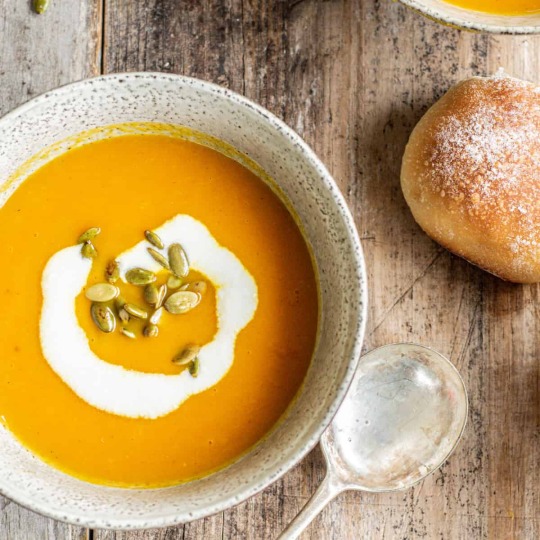
This pumpkin carrot soup recipe is creamy and fragrant. Perfect for enjoying on cold days.
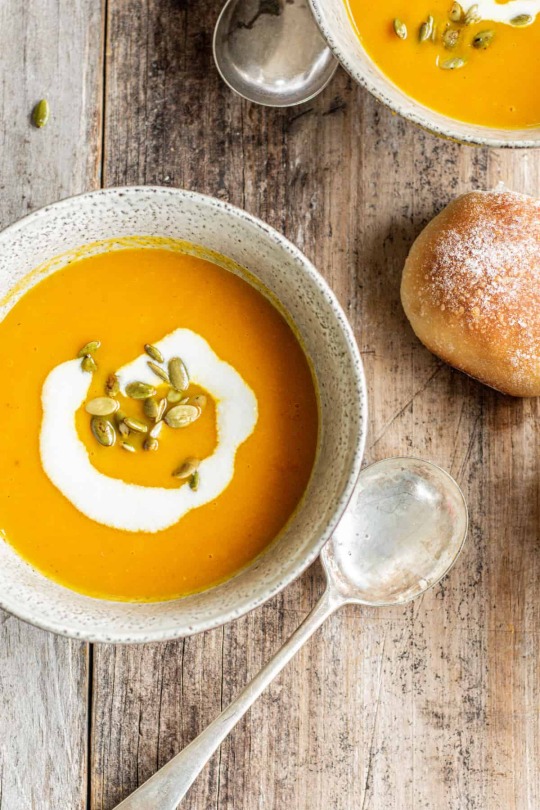
This pumpkin carrot soup is super simple but has a lot of flavor. The base is fresh pumpkin and carrots, but fresh ginger is added. Both pumpkin and carrot are versatile and pair well with many different flavors.
Pumpkins and carrots are packed with vitamins like vitamin C and beta carotene, which are great for the immune system. Serve this carrot pumpkin soup recipe with a hunk of crusty bread and a dollop of yogurt or sour cream.
Try this creamy roasted carrot pasta next!
The ingredients
Find the ingredient amounts for this nutritious pumpkin soup listed in the printable recipe card at the bottom of this post. Here is a rundown of what you will need.
- Fresh sweet pumpkin or a sweet squash.
- Carrots - Fresh sweet carrots pair well with the pumpkin.
- A large onion
- Olive oil
- Fresh garlic cloves
- Ginger - Fresh ginger gives the soup a great kick.
- Vegetable broth or chicken broth - A good quality broth/stock is a must for a delicious soup.
- Fresh lemon juice - just a touch to make the soup a little zingier.
- Roasted pumpkin seeds for topping
- Yogurt or cream for topping. Yogurt or cream brings richness to the soup. The yogurt also brings a tanginess to contrast the soups' sweetness. You could also add a drizzle of coconut milk to make it a vegan soup.
- Salt and black pepper to taste, or chili flakes if you like heat.
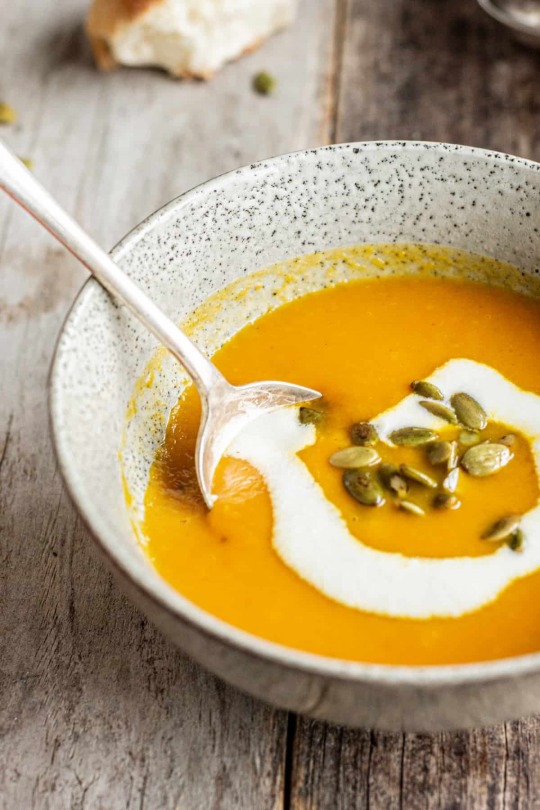
Best pumpkins for soup
When it's pumpkin season, you'll find pumpkins everywhere! The type of pumpkin used in this delicious pumpkin carrot soup makes a big difference in texture and flavor. There is a variety of pumpkin or hard winter squashes you can use for soups and the best varieties have a flesh that becomes smooth and sweet when cooked. They may be labeled sugar pumpkins or baking pie pumpkins.
The more decorative pumpkins used as Halloween props (like the Jack-o-lantern pumpkins) can be quite bland, stringy, and watery. Here are some delicious pumpkin varieties that can be used for pumpkin soup recipes.
- Jarrahdale
- Cinderella
- Autumn Gold
- Golden Nugget
- Queensland Blue
- New England Pie Pumpkin
- Cinderella
- Sugarpie
- Crown
- Musque de Provence
- Kabocha squash
- Acorn squash
- Butternut squash

Equipment
Immersion blender - Also known as a stick blender. It is the easiest to blend the soup until it's nice and creamy. You could use a regular blender or food processor too but you'll need to let the soup cool down first before blending it that way.
Method
Peel and chop the carrots and the pumpkin. The pumpkin cooks a bit faster than the carrots so you can cut the pumpkin slightly bigger than the carrot.
Dice the onion into small pieces and crush the garlic cloves.
In a large pot, heat the olive oil over medium heat. Add the onions and cook until softened and starting to caramelize, stirring occasionally.
Add garlic cloves and ginger and stir for 30 seconds until fragrant.
Add in the diced pumpkin and chopped carrots and cook for 30 seconds, stirring to coat.
Pour over the vegetable or chicken stock and the lemon juice.
Bring the soup to a simmer and let it simmer on low-medium heat until the cooked vegetables are soft, around 15-20 minutes.
Let the soup cool slightly, then use an immersion or high-speed blender to blend it until smooth and creamy. Season it according to taste. If the soup is too thick, add more stock or water to bring the soup to your desired consistency.
Serving
Serve the soup hot. Add a drizzle of cream, natural yogurt, or a dollop of sour cream on top of the soup and a sprinkle of roasted pumpkin seeds. It's the perfect soup for a cold night!
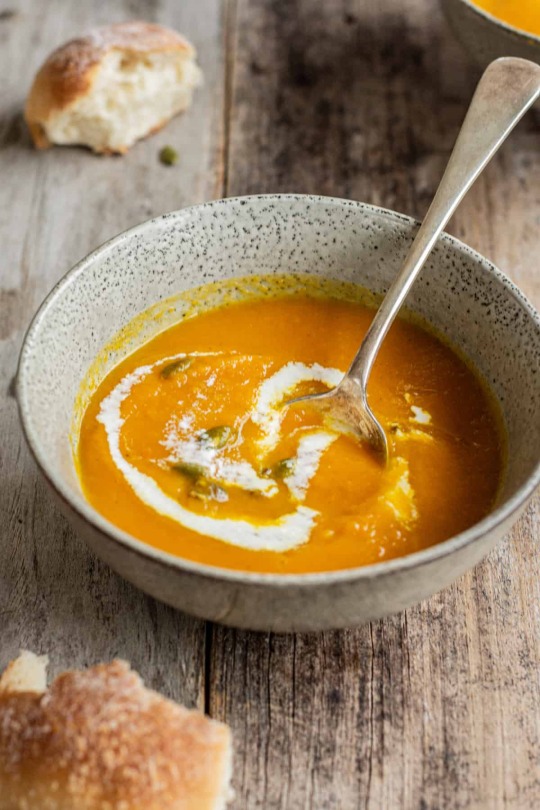
Storing
Leftover soup, once at room temperature, can be stored in an airtight container in the fridge for up to 3 days. It can also be frozen in a freezer-safe container for up to 3 months.
Related recipes
Full Recipe
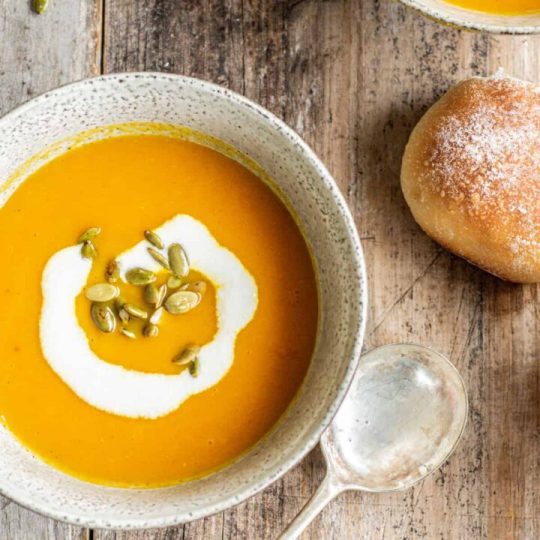
Pumpkin Carrot Soup
Yield:
6
Prep Time:
10 minutes
Cook Time:
20 minutes
Total Time:
30 minutes
This pumpkin carrot soup recipe is creamy and fragrant. Perfect to enjoy on a cold day.
Ingredients
- 900g / 2lb fresh pumpkin
- 450g/ 1lb fresh carrots
- 120g (1 medium) yellow onion
- 3 cloves garlic
- 2 teaspoons fresh ginger, grated
- 1 ½ Tablespoons olive oil
- 1 - 1.25L (4-5 cups) vegetable stock or chicken stock
- ½ tablespoon fresh lemon juice
- Salt and pepper to taste
- To serve
- Yogurt or cream
- Roasted pumpkin seeds
Instructions
Peel and chop the carrots and the pumpkin. The pumpkin cooks a bit faster than the carrots, so you can cut the pumpkin slightly bigger than the carrot. Dice the onion, slice the garlic cloves, and grate the ginger.
Heat the olive oil over medium heat in a large pot. Add the onions and cook until softened and starting to caramelize, stirring occasionally. Add garlic cloves and ginger and stir for 30 seconds until fragrant.
Add the diced pumpkin and chopped carrots and cook for 30 seconds, stirring to coat.
Pour over the vegetable or chicken stock and the lemon juice.
Bring the soup to a simmer and let it simmer on low-medium heat until the cooked vegetables are soft, around 15 minutes.
Let the soup cool slightly, then use an immersion or high-speed blender to blend it until smooth and creamy. Season it according to taste. If the soup is too thick, add more stock or water to bring the soup to your desired consistency.
Serve with yogurt or cream.
Nutrition Information:
Yield: 6
Serving Size: 1
Amount Per Serving:
Calories: 132Total Fat: 4gSaturated Fat: 1gTrans Fat: 0gUnsaturated Fat: 3gCholesterol: 1mgSodium: 622mgCarbohydrates: 22gFiber: 4gSugar: 11gProtein: 3g
Source link
Read the full article
0 notes
Text
Top 10 Best Organic Pumpkin Seeds: Varieties and Pro Tips for Growing Success
Introducing the Best Organic Pumpkin Seeds: 10 Varieties and Pro Tips for Successful Growth!
Autumn Gold Pumpkin Seeds: This variety is perfect for pie-making. Pro Tip: Plant these seeds in well-draining soil and provide consistent water for juicy, sweet pumpkins.
Connecticut Field Pumpkin Seeds: Ideal for carving and decorating. Pro Tip: Choose a sunny spot in your garden and use a trellis to support the vines as they grow.
Jack Be Little Pumpkin Seeds: Tiny and adorable, great for table decorations. Pro Tip: Plant these seeds in a raised bed to ensure good drainage and avoid waterlogged roots.
Cinderella Pumpkin Seeds: Known for their unique, flattened shape. Pro Tip: To encourage larger pumpkins, remove all but one or two fruits per vine as they start to grow.
Big Max Pumpkin Seeds: These giants are perfect for competitions. Pro Tip: Add compost to the soil before planting to provide a nutrient-rich environment for these large pumpkins.
Baby Boo Pumpkin Seeds: Cute, white pumpkins perfect for decorating. Pro Tip: Plant these seeds in a location with good air circulation to prevent diseases.
Jarrahdale Pumpkin Seeds: Gorgeous blue-gray skin with sweet flesh. Pro Tip: Apply a layer of mulch around the base of the plants to retain moisture and suppress weeds.
Howden Pumpkin Seeds: The classic pumpkin for carving jack-o'-lanterns. Pro Tip: Regularly prune the vines to direct energy towards pumpkin development.
Sugar Pie Pumpkin Seeds: Exceptional for making pies and desserts. Pro Tip: Hand pollinate the flowers to ensure proper fruit set and higher yields.
Lumina Pumpkin Seeds: Beautiful, white pumpkins that stand out in the garden. Pro Tip: Use a balanced organic fertilizer to provide the pumpkins with essential nutrients.
Remember, each variety of pumpkin has its unique requirements, but with a little love and care, you'll have a fantastic harvest of organic pumpkins to enjoy all season long.
Happy planting!
Read the full article
0 notes
Photo

👩🏾🌾Hello fellow plant addicts!🙋🏾♀️ I just received my very first seed order from @migardener and I'm sooooo excited 😁😁 I really love the bright packaging and the extensive info on the back! Every year we grow our 🎃pumpkins for Halloween and I picked up a Jarrahdale True Blue Pumpkin and the record breaking Atlantic Giant Pumpkin which can grow to 500-1000lbs each!!! 😲😳 Chad is gonna be so madddd ooooo 🤣🤣🤣 *he hurt his back trying to move a giant pumpkin last year lol 🌶️Also I have 20 pimento plants growing....in winter!!! It's been unusually cold this year🌨️ in California so I finally gave in and got heat mats and seed trays with domes and that did the trick!! Pepper plants usually take about 3-4 weeks to germinate, but with this set up, they started germinating in 5 days!! So I'm hoping that I have a ton of good sized plants for the garden when spring rolls around ❤️ Have you started working in your garden yet!? What are you planting this year!? 🍅 . . . #seeds #seedlings #gardentotable #homegrown #raisedbeds #mygarden #dreamgarden #organicgardening #winter #wintergarden #march #plantlover #plantaddict #vegetables #fruits #plants #garden #gardeninspiration #SoCal #california #losangeles #teampixel #pixelpro6 #californiagarden #zone9b #9b (at California) https://www.instagram.com/p/CpWNBBePX5l/?igshid=NGJjMDIxMWI=
#seeds#seedlings#gardentotable#homegrown#raisedbeds#mygarden#dreamgarden#organicgardening#winter#wintergarden#march#plantlover#plantaddict#vegetables#fruits#plants#garden#gardeninspiration#socal#california#losangeles#teampixel#pixelpro6#californiagarden#zone9b#9b
0 notes
Photo

Roselle Seeds - Asian Sour Leaf (Hibiscus) - Non Gmo - Heirloom Seeds – B25 Roselle Seeds - Asian Sour Leaf (Hibiscus) . Heirloom, Non-GMO. Hibiscus sabdariffa. Other names: Florida Cranberry, Indian Sorrel, Jamaican Tea, Maple-Leaf Hibiscus, October Hibiscus, Red Sorrell, Roselle. 70-90 days. Perennial in zones 9-12. Can be grown as an annual. Hibiscus sabdariffa. Edible leaves and flowers Roselle or Sour Leaf is grown in tropical and subtropical regions. Burmese say "chin baung ywat" which is translated into "sour leaf." It can be grown as a summer crop in temperate regions. The flavor of the flowers buds/leaves are sour tasting and work well with pickling, curries, or prepared with strong and spicy flavors. AKA: Florida Cranberry, Indian Sorrel, Jamaican Tea, Maple-Leaf Hibiscus, October Hibiscus, Red Sorrell, Roselle. Roselle is very sensitive to frost. Prepare fertile sandy loam soil. Sow seeds in spring/summer after last frost in a warm, sunny location. Or start seeds indoors and transplant when weather warms. Keep soil moist. For leaf harvesting, begin 6 weeks after transplanting or when 18" tall, leaving 3-4" of stem. Second cutting and after are done in 4 weeks intervals. Short plants may be thinned out. The fruits are harvested when plants are full grown and can easily snapped off by hand. They are easier to break off in the morning than at the end of the day. Flowers are used in beverages and simple syrups, sauces, jellies, preserves, chutneys. The leaves are prepared fresh in salads or cooked vegetables and used to season curries. http://springsofeden.myshopify.com/products/roselle-seeds-asian-sour-leaf-hibiscus-non-gmo-heirloom-seeds-b25
#Pumpkin#Jarrahdale Pumpkin#Blue Pumpkin#Pumpkin Seeds#Jarrahdale seeds#Pumpkin Dill#giant pumpkin#Pumpkin Polar Bear#Sunlight pumpkin#Pumpkin Cotton Candy#Winter Luxury Pie#Porcelain Doll#Pumpkin Fireball
0 notes
Photo

Jarrahdale Pumpkin
4 notes
·
View notes
Text
Mathias and Everything Overlapping, Pt. 4
(June 27, 2022)
For this post, I had documented the progression of a pumpkin flower. I'm not confident that the fruit will last, buuuuut, one has to try.
instagram
(Post date: June 24, 2022)
The progression of a female pumpkin flower.
1. I want to call this prototypical, but there's probably a better word. This is the flower and pumpkin primordia before it fully becomes a flower.
2. This is the juvenile flower before it opens. It doesn't have it's usual orange color yet. It's separated from the rest of the vine by now.
3. The day the flower opens. I pollinated this by hand immediately after this photo. We can see the primordia behind the flower has become a little more pumpkin-like.
4. A day or two after pollination. The flower begins to die off and curl in on itself as the baby pumpkin grows exponentially. It's hard to see in the photo, but I can even feel the ribs of the pumpkin begin to form at this stage.
instagram
(Post date: June 24, 2022)
A single image.
The miniature potato plants are beginning to tuberize. I've kept them deliberately small for the sake of space and iteration.
Here, I hold a Pirampo OP flower; they have a saturated, violet (blue) center with white edges.
It hasn't totally opened yet, so I'm unable to see the anthers. Since none of the other minis are flowering, I'll allow this one to set self-seed.
With the amount of anthocyanin in the plant above ground, I can only hope for purple in the tubers as well.
I wanted to get some selfed seed from the Pirampo, but I'm not sure that it would keep the berries. The flowers ended up having purple (blue) corollas and yellow anthers.
These are all the updates that I had yet to make Tumblr posts about.
#backyard alchemist#original post#tps#tps seedling#true potato seeds#cucurbita maxima#jarrahdale pumpkin#pumpkin plant#potato breeding#potato flowers#Instagram
0 notes
Text
I'll post more garden pictures when they're less mosquitoes everywhere >,<
Also, it's that time of year! As of September 12, 2022, Walmart has pallets of pumpkins in stock!
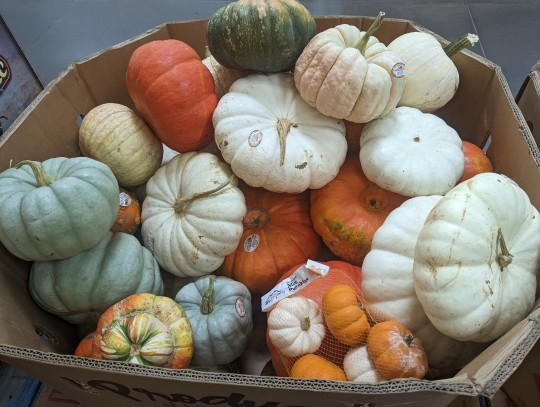
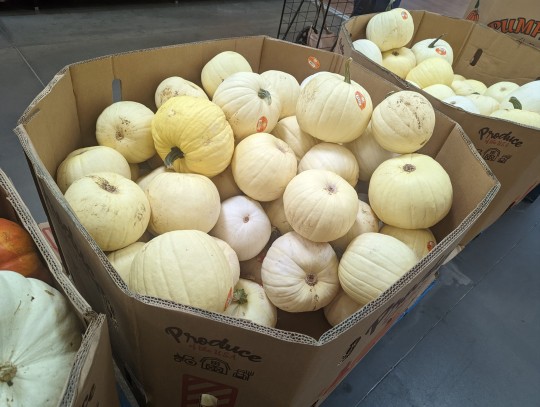
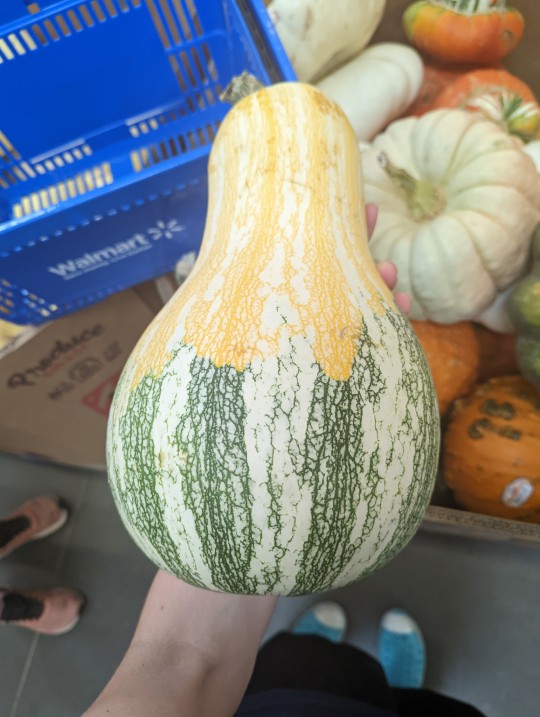
[three images, each showing a large pallet box of pumpkins at Walmart. The first is a rainbow mix of winter squash, the second is all medium white pumpkins, and the third is focused on a single Cushaw squash held in the hand of a white person, which is shaped like a butternut squash, with an orange top, green bottom, and mottled white vertical stripes. End ID ]
Buying "pumpkins" at Walmart and other grocery stores is a quick and easy way to get a few hundred seeds from a dozen or more Winter Squash varieties, and you can use them for homemade pumpkin pie and other desserts after baking*.
Some of the possible heirloom squash varieties (and their hybrid descendants) on display here:
Jarrahdale Blue and Queensland Blue (C. Maxima)
Flat White Boer (C. Maxima)
Turk's Turban (C. Maxima)
Musquee de Provence (C. Moschata)
Rouge vif D'Etampes (C. Maxima)
Porcelain Doll F1 (C. Maxima)
One Too Many F1 (C. Maxima)
The Cushaw in the third picture is most likely Autumn Colors F1, ( C. Mixta or C. Aegyrosperma depending on who you ask.)
To save Winter Squash seeds, all you need is a sturdy knife, some good arm strength, and a strainer; chop the squash in half (carefully! Their hard outer shell makes them store well but also makes them difficult to cut), scoop out the seeds, and give them a good rinse in the strainer before laying out in a single layer on a screen or plate to dry for a few days before storage.
*To make homemade pumpkin puree out of any winter squash: simply chop, deseed, roast until fork-tender, puree, and then allow to drain over a bowl in cheesecloth-- and keep that 'pumpkin juice' for watering plants or perhaps use it in fall drinks?
You can also cook squash by boiling it, as well as in a slow cooker!
13 notes
·
View notes
Text
Just had a forlorn garden experience...many seeds I’ve sown haven’t germinated. I started a Jarrahdale pumpkin mound and it’s first sprout was due today...but nothing in sight. I could say it’s never too late to restart seeds but that’s inaccurate, seasonal timing is everything! Such is life
78 notes
·
View notes
Text
2019 year in review
My last pumpkin patch went on so long I kind of forgot to do a year in review. Happy to say 2019 was my most successful garden year! 🙌🎃
Harvested 36 pumpkins - my most ever! Double my best year before
6 Racer Plus
11 Pyrolga
6 Neon
7 Jack Be Little
1 Jarrahdale
5 Lil Pump-ke-mon
First time I’ve gotten at least one pumpkin from every variety I planted
First time I grew one larger than the variety’s advertised size
Twice broke my record for largest pumpkin (20lbs)
Latest harvest and longest seed-to-harvest I’ve ever had - I started Jarrahdale seeds June 23 and harvested January 21. That’s 7 months
Lessons learned
Digging deep and amending well really does make a difference. This was the first 3′+ deep bed I’ve done and the big ones grew easily
1′ deep soil isn’t worth it for pumpkins. me @ me don’t you dare do this again in 2020, it won’t magically be different this time. Plant something else there
You can cut back on nitrogen at the flowering stage but don’t eliminate nitrogen entirely, that might be what nearly killed the Jarrahdale
Kellogg soil says it’s ready-to-plant and doesn’t need to be mixed with anything but this is a lie
A pumpkin does nearly all of its growing in the light green stage, once it’s dark green it won’t grow significantly larger no matter what you do
I think growing 36 pumpkins, many of them so small I hesitated to count them, is enough that I might finally be able to start prioritizing quality over quantity like a competent gardener probably should. Will I still feel that way in September? ¯\_(ツ)_/¯
13 notes
·
View notes
Text
I'm addicted to pumpkins
Not pumpkin spice - the whole flippin' thing.
It started with a baking project where I used almost the whole thing and told myself, "Well, that was a baked sweet. I want to really try some more savory recipes."
Went to a farm for baby pictures and picked up a cheese wheel pumpkin to try and be adventurous and made rabbit stew with it. It's one of my favorite recipes now and I'm hooked.
I'm roasting the seeds as we speak.
Does anyone have recipes, recommended varieties, or anything else to contribute? I have a Blue Jarrahdale to try after going through the cheese wheel. Maybe I'll try a curry or a risotto? I'm willing to share my success stories!
7 notes
·
View notes
Note
For the autumn ask thing: fuzzy socks :)
From this autumn ask meme.
I didn’t see fuzzy socks as a question,so two answers for one ask.
fuzzy boots: if you could livein any year/era, which would it be and why?
Honestly? I’d stay in the present. It’s easy to romanticize the past (I do it all the time about the90s, back when everything still seemed more stable—the government,the economy, the weather. Back when I still felt like I personallyhad a future and so did the rest of humanity. Plus the music wasbetter and even the worst sweatshop trash clothing was higher qualitythan a lot of what’s around today. A return to pre-9/11 innocence,what bliss), but even as the world is falling to shit, I still feellike we’re on the cusp of so many great discoveries that canalleviate human suffering. Cures for cancer and other medicalmiracles, feasible clean energy, that kind of thing. And I wouldn’twant to give up what we already have, even if that means I have tokeep MRSA and coral bleaching.
If I absolutely had to go back, likethe angels got the phone box, I wouldn’t want to go any time beforethe 1950s. Antibiotics, telephones, and being able to wear pantswithout being arrested… it’s the little things that make lifebearable.
For any other era, maybe aPre-Columbian Native American, sometime between 1000 and 1300 CEprobably. It was a high point for a lot of cultures thanks to a fewhundred years of decent weather. At least, east of the Mississippi;not as much in the Southwest. Since I know the most about the Lenapeand I live on their land, I’d pick them. So basically, exactly whereI am now, but eight hundred years ago. The land is fertile and foodabundant, the weather extremes aren’t usually too extreme, and theonly natural disasters to worry about are floods and hurricanes. Thesociety is more or less an inclusive socialist matriarchy with aparadigm of forgiveness over punishment and learning from everyexperience. The Lenape were called “a nation of women” byneighboring nations; they were the arbiters and peacemakers, neutralin war (and in whole Eastern Woodlands region, women generally filledthat role in society—disputes and problems were taken to thematriarch of the family or the sachem/ chief’s wife [or mother, ifshe was still alive]), so not much violence.
I mean look, if I’m going to live alife of pre-industrial (or, well, pre-electronic, but same thingreally) toil and die of something we can prevent today with somesoap, I’m going to pick somewhere where life was otherwise relativelyeasy and fair. Eurasia any time after the rise of agriculture? Nofucking thank you. Anywhere in the tropics, ever, in any period ofhistory? Nope, I’d rather avoid eye worms, even if it meansyear-round fresh fruit and no chance of frostbite.
wool socks: what’s somethingyou look forward to in fall?
Putting up the harvest, though thisyear everything was bad again because of weather and deer. I reallylook forward to getting the garden ready for winter, too. I know Ishould do more with cover-cropping and three-season growing, but I’vehad limited luck with fall and winter crops because of my location (Idon’t get as much light as I need because I live on a north-facingslope; the mountain blocks like 50% of the ambient light from thesouth during the summer solstice, so I get even less light in springand fall). I think there’s something cathartic about ripping outplants and mulching over all the mistakes I made for the year. "Nextyear I’ll do better" still seems like a possibility then.
I get so jazzed about pumpkins andwinter squash, but this year was another terrible year. Ihave one single buttercup and one mystery squash that I’m thinking isLower Salmon River, but who knows. I planted like 8 differentvarieties plus home-saved seeds with mystery-dad genetics (Jarrahdale and Rouge Vif D’Etampes mothers; both were amazingly prolific and super tasty in 2016 and if I could only grow one variety ever again it would be one of those two because they’re five stars for size, flavor, and keeping quality). Istarted out with over 20 squash plants this year, but deer continuedto lay waste to them all summer, despite my best attempts at keepingthem at bay. Fucking deer. Next year I’ll do better.
Thanks for asking! :D
4 notes
·
View notes
Text

Love these blue-green Jarrahdale pumpkins - I need to remember to save some seeds for next year
1 note
·
View note
Photo

You simply must try this delicious heirloom baking pumpkin from New Zealand! Each heavily ribbed blue-green-white fruit is packed with stringless golden flesh so rich and aromatic you may just have to eat dessert first. And the pumpkins make terrific Halloween decorations, their ghostly appearance unlike any other in the garden!
The first thing you will notice about these pumpkins is that they are heavier than they look. Nicely shaped with a slightly flattened appearance and good ribbing, they have strong handles and a flat base for easy displaying. But inside, Jarrahdale is all business: this squash is packed with rich flesh that will delight your palate and fill your pantry. From a 6- to 10-pound pumpkin you will get several quarts of top-quality eating, whether you use the flesh in sweet or savory dishes. And the aroma is heavenly!
And unlike many heirloom varieties, Jarrahdale is heavily productive. It was bred for high-heat climates, so it's an ideal choice for the hot south and southwest, though you will find it very adaptable to northern climates as well (and it's a good crop for short growing seasons, surprisingly). Expect at least half a dozen fruits from each vine, all colored a slightly different shade of ghoulish Halloween bluish-green to gray!
Jarrahdale stores well, so you can display this good looker for a few weeks, then cut into it for its delicious flesh. Its portable size, unusual color, and fantastic flavor all combine to make it a terrific all-around favorite, ideal for whatever you desire in a pumpkin! We highly recommend it to gardeners in all climates. ...
Jarrahdale Pumpkin Seeds from Park Seed
1 note
·
View note
Photo
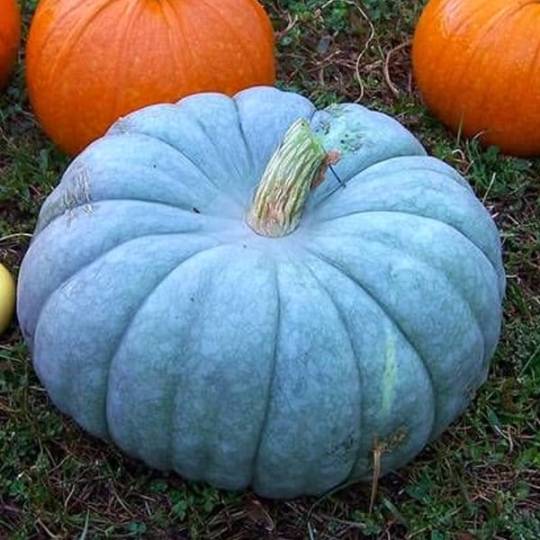
Exotic Jarrahdale Blue Pumpkin Seeds Cucurbita maxima, Vegetable Seed, Organic, Heirloom NonGMO B10 Stunning heirloom pumpkin from New Zealand with stunning blue-green skin. Jarrahdale pumpkins are a stunning blue green on the outside with a deep orange on the inside. Lovely and decorative, this pumpkin with stunning blue-green skin comes to us from the town of Jarrahdale in New Zealand. Weighing in the 8-10 lb. range and 10" tall, the flattened, firm-ribbed fruits have mild, slightly sweet, almost fruity, golden-yellow flesh that's highly aromatic. Nicely ribbed, these are a Jack O' Lantern fancy pumpkin. Authentic Jarrahdale seeds to grow blue pumpkins about the size of a basketball. Great for fall decor, farmers market or just making your garden more exotic. Australian variety is very unusual. The skin is an attractive ribbed blue-gray. Ten-pound fruit can be 34 inches around and the flesh is orange and sweet. Stores well. Count:~10 Full Sun Sprouts in 5-10 Days Ideal Temperature: Optimum soil temperatures 70-85ºF Seed Depth: 1/2-1 inch Plant Spacing: 18-36" Frost Hardy: No Cucurbita maxima 100 Days to Full Maturity - Annual Crop - Not Intended to Over-winter - All Zones in the U.S.A Our pumpkins are all Heirloom, Non-GMO, Open Pollinated and beyond organic. Sustainable Seed Company - Family Owned & Operated - Premium Quality - Ethical & Sustainable Seeds Growing Tips: Direct seed, or set out transplants after the last frost date. Don’t let transplants become rootbound; don't disturb roots while transplanting. Needs rich soil. Harvest when rinds become very hard. Plant in fertile soil, amended with compost or well-rotted manure and keep well watered. They benefit from growing on black plastic and by using row covers for weed, insect control, and more rapid growth. Very good keeper. Showy and makes a spectacular presentation with orange pumpkins. Excellent for market grower or home gardener. How to Sow and Plant Sow in fertile, warm soil after the danger of frost has passed. Sow seeds directly in the garden. Give large-fruited pumpkins plenty of room to ramble. For improved drainage sow in mounds, or hills of soil 12 inches in diameter, 6-8 inches tall. Sow in groups 4-6 seed about 3 inches apart. Each group should be about 4-6 feet apart. Cover with 1 inch of fine soil and firm lightly. Firm lightly and keep evenly moist. Seedlings emerge in 7-14 days. Do not plant pumpkins and other squash family crops in the same spot 2 years in a row. Sowing Indoors: 3-4 weeks before the last frost. Provide 70-85ºF soil temperature. Sow 2-3 seeds per cell/pot. Sowing into individual biodegradable peat/cow pots reduces root damage when transplanting. Transplant after last frost, 36-48" apart. Sowing Outdoors: Sow after the last frost when the soil temperature is over 70ºF. Sow a few seeds every 36-48". How to Grow Thin seedlings to 2-3 per group when they are 1-2 inches high Keep weeds under control during the growing season. Weeds compete with plants for water, space, and nutrients, so control them by either cultivating often or using a mulch to prevent their seeds from germinating. Keep plants well-watered during the growing season, especially during dry spells. Plants need about 1-2 inches of rain per week during the growing season. Use a rain gauge to check to see if you need to add water. It's best to water with a drip or trickle system that delivers water at low pressure at the soil level. If you water with overhead sprinklers, water early in the day so the foliage has time to dry off before evening, to minimize disease problems. Keep the soil moist but not saturated. Pumpkins are “dioecious” having both male and female flowers on the same plant. Male flowers will open first and the female flowers will open later. Do not move or step on vines as they are quite fragile. Monitor for pests and diseases. Check with your local Cooperative Extension Service for pest controls recommended for your area. If you are trying to grow extra-large pumpkins, allow only one fruit per plant to mature. Beds of vigorous, sprawling pumpkin vines can be bordered by corn, towering pole beans, sunflowers, and other trellised or vine vegetables. Harvest: Before heavy frost. Determine ripeness when the skin has turned color and becomes dull dry. You will be unable to create a dent when pressing your thumbnail into it. Leave two inches of the stem on the squash and manage carefully so there is no damage which can shorten storage life. Cure for 7-10 days in the sun to harden the rind and increase storage quality. Wipe any debris off skin before storing in a cool dark place with 50-55ºF temperatures and 50-65% humidity. Jarrahdale squash, raw Amount Per 1 cup, cubes (116 g) Calories 40 % Daily Value* Total Fat 0.2 g 0% Saturated fat 0 g 0% Polyunsaturated fat 0.1 g Monounsaturated fat 0 g Cholesterol 0 mg 0% Sodium 5 mg 0% Potassium 406 mg 11% Total Carbohydrate 10 g 3% Dietary fiber 1.7 g 6% Sugar 2.6 g Protein 1.1 g 2% Vitamin A 31% Vitamin C 23% Calcium 3% Iron 3% Vitamin D 0% Vitamin B-6 10% Cobalamin 0% Magnesium 4% *Percent Daily Values are based on a 2,000 calorie diet. Your daily values may be higher or lower depending on your calorie needs. Tags; Jarrahdale Pumpkin, Queensland Pumpkin, Blue Pumpkin, Blue Cinderella Pumpkin, Blue Fairytale Pumpkin, Blue Doll Pumpkin, Blue Moon Pumpkin, Jarrahdale seeds, Pumpkin, Halloween Pumpkin, Heirloom seeds, Non-GMO seeds, vegetable seeds, organic seeds FREE GIFT when you order 5 items or more. Free gift is full of surprise seeds which may include single or mixed varieties. Note: No tracking # will be provided to make the shipping cost-effective for us and free for you. Returns & exchanges Not accepted. But please contact me if you have problems with your order http://springsofeden.myshopify.com/products/exotic-jarrahdale-blue-pumpkin-seeds-cucurbita-maxima-vegetable-seed-organic-heirloom-nongmo-b10
#Jarrahdale Pumpkin#Blue Pumpkin#Jarrahdale seeds#Pumpkin Seeds#Jack O' Lantern#Halloween Pumpkin#Heirloom seeds#Non-GMO seeds#organic seeds#Queensland Pumpkin#Blue Doll Pumpkin#Blue Moon Pumpkin#Cucurbita maxima
0 notes
Text
Mathias and Everything Overlapping, Pt. 2
(June 27, 2022)
Like the previous year, I've been having trouble keeping the field clear of grass. I may have to give in and raise the beds slightly to evade it for the next year.
instagram
(Post date: May 29)
1. I have a soft spot for cucurbita, as temperamental as they may be. This is Cucurbita maxima, variety Jarrahdale. In other words, a funny-coloured pumpkin.
instagram
(Post date: May 31)
1. The potato seedlings. Between my First Year Mistakes, the unruly weather, and natural selection, this is what's left of the round. All are from Cultivariable.
2. Qoyllu OP has rather long, pointed leaves. Not what I usually expect of potatoes. However, it likes to stretch over its little pot.
3. Pirampo OP 1 looks more like the potato I'm used to. The leaves are clumped together and it seems to bush out naturally. It's probably the sturdiest one.
4. Bloody Banana OP is... Something. I'm not sure I'd identify this as a potato if I saw it growing wild. But, I like the shape of the mother variety (Bloody Banana), so I'm hoping this seedling also has the fingerling quality. The foliage is somewhat sparse.
5. Jancko Ajawiri OP, my poor little Ajawiri. It's very small and I've been giving it extra love. I may have to plant even more than I did this year just to give them a chance.
6. Pirampo OP 2 is similarly stunted to the Ajawiri, I'm not entirely sure why. It seems that the other plants are simply thriving more.
By the time I'm making this post, the mini potatoes are doing all right. I hope that I can get some nice teeny tubers with a decent dormancy period.
#backyard alchemist#original post#growing your own food#true potato seeds#tps#cucurbita maxima#jarrahdale pumpkin#pumpkin plant#Instagram
0 notes
